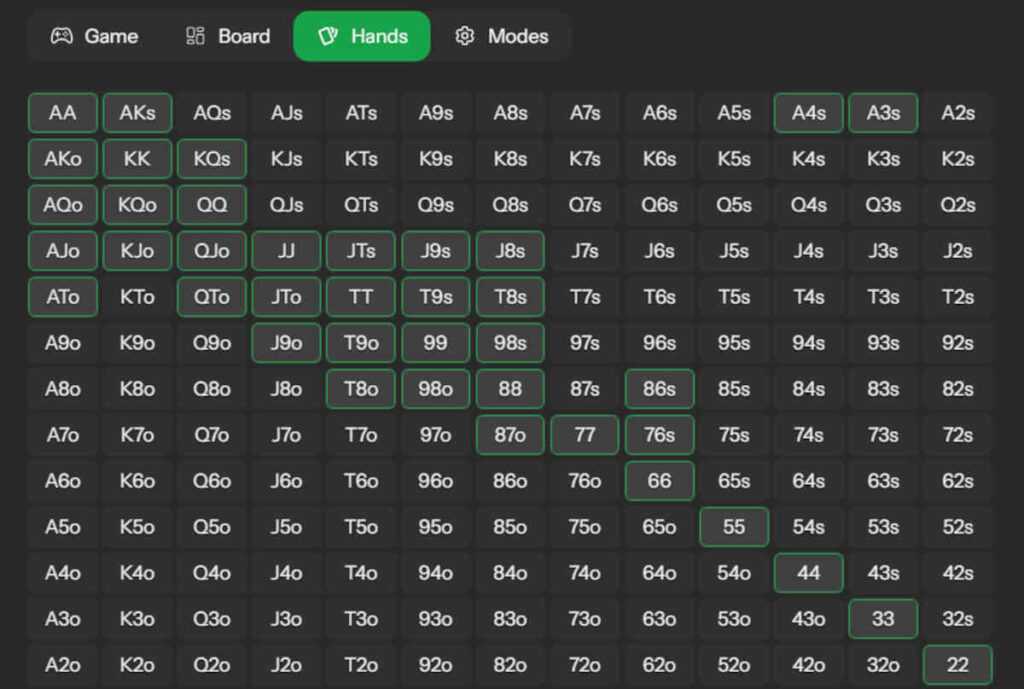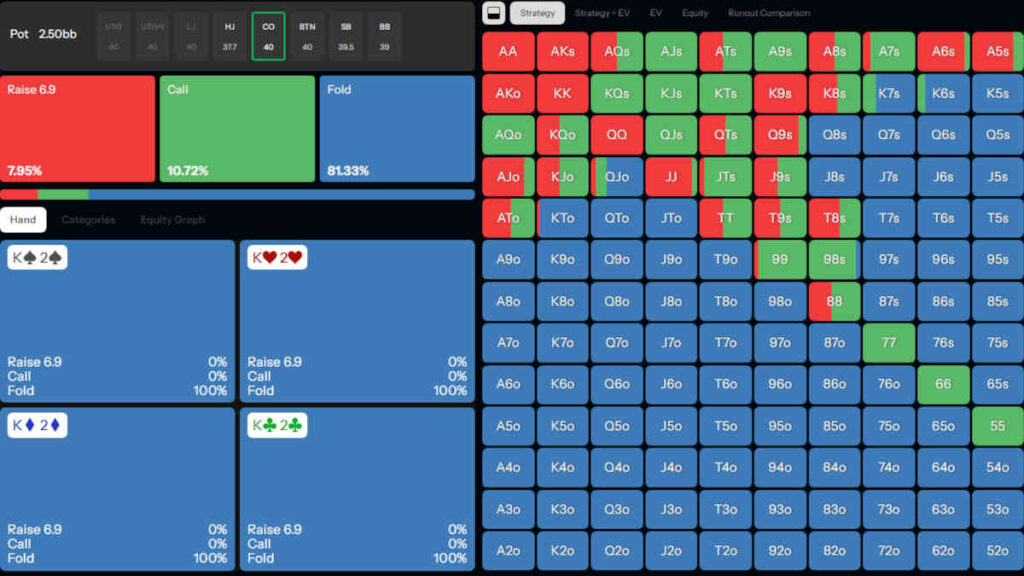Ever since being introduced about a decade ago, poker solvers have changed the way we think about poker. But what exactly are they and how do they work?
These elaborate pieces of computer software have been able to solve countless poker scenarios and bring insight into how poker should be played in theory.
Unlike human players, poker solvers “think” in terms of perfect balance, which makes their game completely unexploitable.
If you are new to poker solvers, keep on reading to learn what they are, how they can help you, and which poker solvers you should try using.
What Are Poker Solvers?
Before we go into any specifics, let’s answer the most basic of questions. What are poker solvers, and what do they do?
Poker solvers are pieces of poker software that create optimal strategies, often called solutions or solves, based on user inputs.
A poker solver can’t tell you what an optimal strategy is in any given scenario without being given a number of inputs.
These inputs include player stack sizes, preflop ranges, previous actions, and pot size. Once you input all of these, the solver gets to work and tells you how to play different hands in your range.

So, while poker solvers can help you figure out the best play in a given scenario, they can only do so based on a number of inputs, some of which boil down to assumptions, while others are factual.
For example, you can know the stack sizes and pot size for sure, but you can’t know what hand range exactly your opponent plays preflop.
The solver will also require you to input a few bet sizing options, and it will choose between these bet sizes only. This limits the solutions, as each player could, in theory, make an infinite number of different bets in a no-limit poker game.
Game Theory Optimal (GTO) Strategy Explained
Poker solvers are designed to create game theory optimal (GTO) solutions. A GTO poker strategy is one that revolves around balance and making your hand range unexploitable.
Playing poker the GTO way means playing it mathematically perfectly. Every bet you make is designed to keep your range balanced and make it impossible for your opponents to take advantage of your strategy.
In turn, GTO solutions don’t take full advantage of your opponents’ potential flaws either. In fact, poker solvers don’t even consider player tendencies in their solutions.
For that reason, the GTO solutions you get from your solver can be used to play against anyone, whether they are tight, loose, passive, or aggressive.
Studying GTO poker strategy by examining various poker solutions is the best way to get a good grasp on how to play a well-balanced strategy that works against any player.
How to Use a Poker Solver
We have explained what poker solvers are, so now it is time to explain how they are used. Most poker solvers are fairly similar, so learning to use one will basically mean you can use any.
Before you can run a simulation, you will need to provide your solver with inputs it will use to provide you with a solution.
There are a few steps to using a poker solver, so let’s run through them quickly and explain each part of the process.
Building a Game Tree
Before you can run any poker simulation, you have to create a game tree. This is a visual representation of all the possible actions in a poker hand.
In No Limit Texas Hold’em, there is an infinite number of options players can take. A solver needs you to narrow these options down and provide only a few bet and raise sizes for each betting street.
If you were to run a poker simulation with every option, the simulation would last infinitely long, as the solver would have to account for every possible bet size on every street.
Instead, you will input a few bet and raise sizes that the players can use. Typically, players input a small bet size, such as 33%, a large bet size, such as 66 or 75%, and an overbet size.
This way, the solver will only solve for three bet sizes across all streets, providing you with a solution in a reasonable timeframe.
Providing Hand Ranges
Poker solvers are not poker players, and they don’t really know what hands they might want to play from any position or in any situation.
For that reason, you have to provide the solver with the exact hand ranges that you and your opponents might play in a given hand.
The first thing you must do is provide your range. This is quite easy, as you will know what hands you would play in the hand you are solving for.

The next thing you must do is input an approximate range for your opponents. This will require some guesswork, as you will have to input a range without actually knowing how correct it is.
You can make these assumptions based on your ranges and your best guess on how your opponents usually play.
Running the Solution
It’s time to run your solution. Once you have input all the relevant data, run the solve and let your poker solver do its magic.
Since the solver can’t play poker, it will run thousands of simulations and adjust each player’s strategy to a point of complete equilibrium.
If you want a fast solution, you will instruct your solver to stop short of equilibrium, as this saves a lot of time while providing a nearly perfect solution.
The solver will instruct you on the action to take with each hand in your range, based on the few potential recommendations you provided.
Learning from the Results
Once the solver is done running its simulations, it will provide you with a detailed solution for your hand.
The solution is presented in a visual form of a hand grid. For each hand in your range, the solver recommends an action you should take.
For example, if you gave the solver bet sizes of 33%, 66%, and 125%, it will tell you which hands to use for each of the bet sizes at what frequency.
Don’t be surprised to see the solver recommend you check with a hand 50% of the time and bet 66% of the pot 50% of the time. This is called a mixed strategy, and it creates the perfect balance in your range.
Of course, humans can’t remember all the ranges by heart, especially when it comes to mixed strategies.
What is possible, however, is to learn from the solver solutions and get a good feeling for how the solver chooses the hands to put into different brackets.
Once you understand this, you will be able to play a semblance of a GTO poker strategy without having to run the solves, but based on your intuition and understanding of what GTO strategy seeks to do in the first place.
Poker Solvers vs. Exploitative Poker Strategies
Poker solvers like GTOWizard are among the best tools for studying poker, offering an unbiased strategy that can be applied against any player worldwide.
However, unexploitative poker strategy is not always the most profitable one, and GTO poker strategy aims to protect your range from being exploited, instead of exploiting your opponents’ tendencies.
To that end, it is worth keeping in mind that solver strategies exist to be deviated from, and that all the best players in the world make adjustments to GTO strategies based on what they know about their opponents.

For example, if you are playing in a home game with your friends, you should not be looking to balance your ranges and always make an unexploitable play.
Instead, you can get away with adjusting your bet sizes to your hand strength and other plays that would be very transparent to more capable opponents.
The truth is, your poker strategy should always be adjusting to the players you are playing against, with solver strategies acting as your baseline.
GTO Poker as the Perfect Baseline
The greatest advantage to studying poker with solvers is that you get to learn the baseline strategy that works against any opponent in a complete vacuum.
Once you know what the baseline is for every play, you can start making adjustments that actually make sense, rather than guessing and hoping.
For example, imagine you reach a flop and the solver tells you that the optimal play is to bet 30% of the time for a ¾ pot size.
If you know this is the baseline, you can easily adjust to your opponents. If your opponents tend to be sticky, you can c-bet even less often. Only bet your best hands and increase the size even further.
On the other hand, if your opponents tend to play a fit-or-fold strategy, you can probably get away with c-betting more often, and possibly decreasing your bet size.
However, if you don’t know what the baseline c-betting frequency is on the flop, you have no real way of making a reasonable adjustment to your play.
Use Poker Solvers as Your Ultimate Training Tools
Poker solvers are easily the most valuable tools you have at your disposal as a poker player. Completely unbiased and based in pure math, the solver strategies are the closest you will get to playing “perfect” poker.
If you don’t have any experience with solvers in poker yet, we recommend getting some basic tools like PokerSnowie and taking baby steps into exploring the world of GTO poker.
Remember, even if you plan to play an exploitative poker strategy for the most part, learning GTO poker and knowing the baselines is the best way to make good deviations and actually exploit the tendencies of your opponents.


